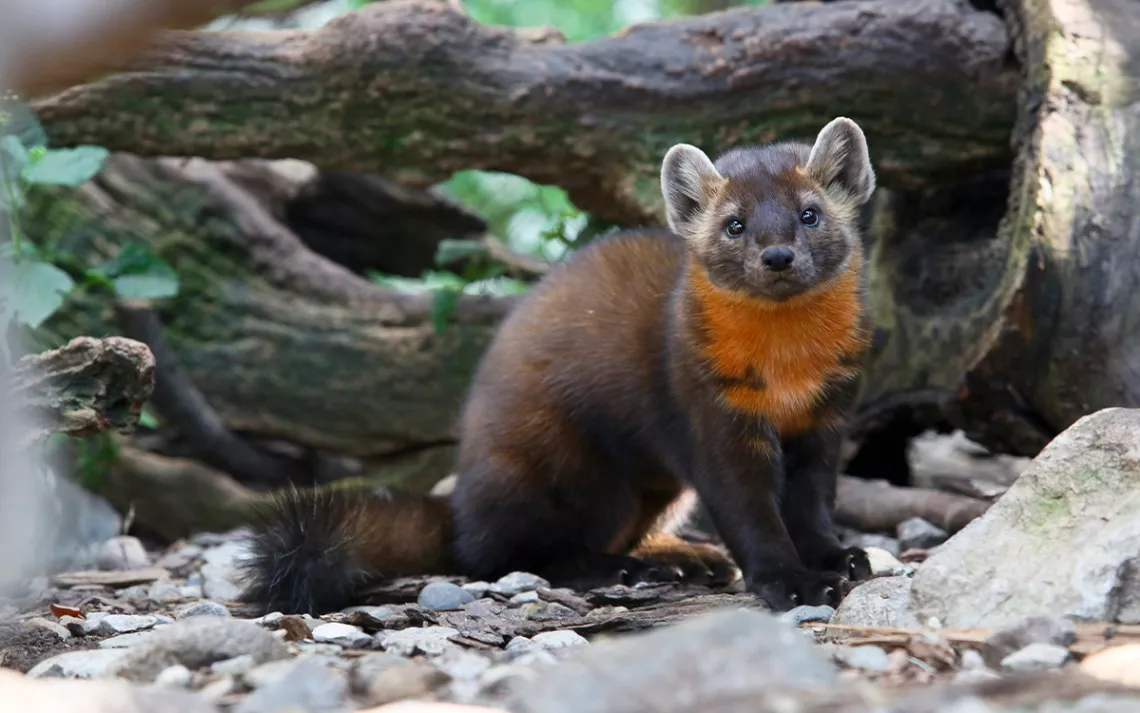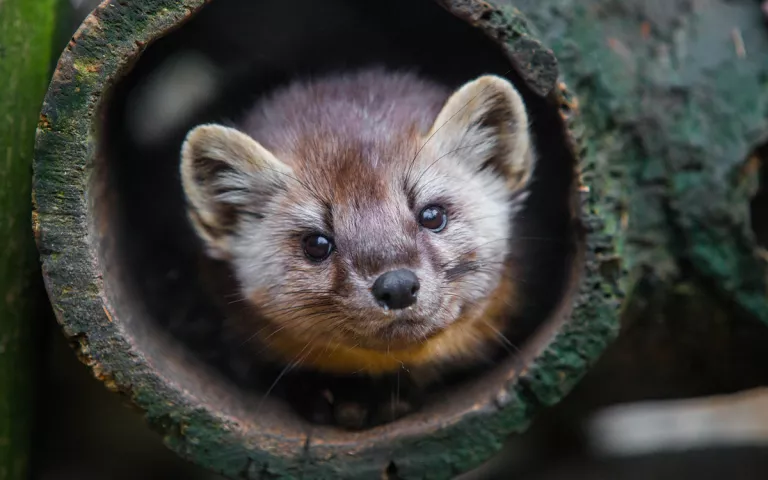Pennsylvania Plans to Bring the American Marten Home
The future for this member of the weasel family looks bright in the Keystone State

A marten at ZooAmerica in Pennsylvania. | Photo courtesy of ZooAmerica
On a humid morning in late July, Mitzi was hiding in her den box at ZooAmerica in Hershey, Pennsylvania. Mitzi is an American marten, a small member of the weasel family that is native to the forests of northern North America. Tal Wenrich, the zookeeper who has cared for Mitzi since she arrived here from Minnesota nine years ago, was attempting to coax her out. Crouched by the box’s tiny opening, he proffered a syringe of diluted grape jelly, a favorite treat. Mitzi’s nose appeared first, sniffing. Her whiskers twitched, and then she emerged, slipping out in one slinky motion. She trotted over to lick the jelly, her fluffy tail curled upward like a question mark.
Dean, Mitzi’s neighbor, was more cautious about accepting the jelly, observing Wenrich from a wooden beam several feet up. While Wenrich waited for him to climb down, a kid on the other side of the enclosure pointed at Dean. “He’s so cute!” he squealed. “I want to pet him!”
Dean and Mitzi are the animal faces of a state initiative to reintroduce the American marten to Pennsylvania’s forests; they are the furry stars of online promotional materials for the project. Once a common species, the marten largely disappeared from Pennsylvania more than one hundred years ago, the result of unregulated hunting (the marten was easy to trap and prized for its fur) and widespread deforestation that also devastated the state’s populations of elk, deer, wolves, mountain lions, turkeys, and beavers.
Thomas Keller, furbearer biologist for the Pennsylvania Game Commission, is leading the effort to bring the American marten back. For more than two years, Keller has researched the marten’s history and its potential future in Pennsylvania, gathering information from archives, data analysis, and scientists in other states who have recently reintroduced the marten, like Jay Kolbe, a wildlife biologist in Montana who is monitoring martens that were released in the Little Belt Mountains starting in 2020.
In July, the board of the Pennsylvania Game Commission voted to postpone the release of a comprehensive reintroduction and management plan for the marten pending another public survey. (A previous survey found that 92 percent of Pennsylvanians supported the project.) Once the plan is released, it will face a 60-day review and comment period before it can be finalized, with approval coming as early as January 2024.
To educate the public about the marten, Keller has crisscrossed Pennsylvania, giving lectures and answering questions. His first task is often to explain what an American marten is. “There’s been generations of Pennsylvanians come and gone since we had martens,” Keller said. “Most of us have forgotten about it.”
American martens weigh between one and three pounds, and their coats come in shades of mocha and chocolate brown, depending on the season, with smudges of peanut butter orange at the throat. They have long, flexible bodies, bushy tails, and oversize paws, which they use for climbing and for navigating snow. Their historical range stretched from Canada, Alaska, and the Rockies to New England and down the Appalachians.
In The Mammals of Pennsylvania and New Jersey, from 1903, Samuel Rhoads described them as “ever shy and retiring from the abodes of man,” with a preference for living in the hollows of trees or in the nests of gray squirrels, which they “evict without ceremony.” They eat mice, voles, insects, seeds, and other plant material. When they aren’t sleeping, martens are hyperactive and mischievous. Wenrich told me that Mitzi and Dean have stolen his phone.

A marten peeks out of a hollow log at ZooAmerica. | Photo courtesy of ZooAmerica
Keller’s presentations highlight the benefits the marten brings to the forest ecosystem, like seed dispersal and rodent population control. He emphasizes that martens are not a threat to people, wild turkeys, pets, or backyard chickens. And he explains the project’s place in the history of successful rewilding in Pennsylvania. “My grandparents’ generation reintroduced the white-tailed deer and the turkey. My parents’ generation reintroduced the bald eagle and the river otter,” he said. “Our generation has a new opportunity to reintroduce the marten.” Other than the wolf and the mountain lion, dicier prospects because of their complicated relationship with people and livestock, the marten is the last mammal candidate for reintroduction in Pennsylvania.
For all his marshaled scientific evidence, Keller’s most effective tool for raising awareness is probably the marten’s photogenic face. Kamryn Powell, a biology student at Indiana University of Pennsylvania, attended one of Keller’s lectures and was immediately enchanted by the marten and its story. “Honestly, right away, its cute little face caught my attention,” she said. “It looks adorable.” Inspired by Keller’s call to action and motivated by the chance to help “right a wrong,” she founded the Pennsylvania Marten Restoration Project. Powell posts on social media about wildlife and conservation in Pennsylvania, featuring victories like the return of the osprey and the beaver. She also hangs informational flyers in the rural northern counties where the marten is most likely to be released. “How cool would it be to be a part of something that could change our history,” Powell thought when she first heard Keller speak.
In the chilly basement of the Academy of Natural Sciences in Philadelphia, I followed Ned Gilmore, the collections manager for the Department of Vertebrate Zoology, down a corridor lined with locked cabinets and animal bones. The air smelled strongly of mothballs. Gilmore opened a drawer, revealing two preserved American marten skins that were collected in Pennsylvania more than a century ago. The female was donated in 1892; she was killed by hunters “after having made a raid on their butter.” The martens’ thick fur, tawny brown with cream-colored patches, is still silky soft.
Rhoads noted that the Pennsylvania marten had “lighter fur” than its Canadian cousin. If the reintroduction is approved, testing could show how Pennsylvania martens differed genetically from other American martens, and which surviving populations in other states, like New York, are most similar. Kolbe told me that genetic analysis of marten populations elsewhere in Montana, Idaho, and Wyoming was used to determine which martens to capture and release in the Little Belt Mountains.
Around the corner hangs a rare skull of the eastern elk, shot in Pennsylvania in the 19th century, a huge, majestic thing with tufts of fur still clinging to its blackened antlers. The eastern elk is considered extinct, though the state reintroduced elk from Wyoming in 1913, and today you can see them in northern Pennsylvania. The museum’s elk and martens are links to pre-colonization Pennsylvania, a landscape that was named for its impressive forests. They are reminders of the costs of short-sightedness, of what has been lost forever—and what might yet be imperfectly repaired.
“I remember my grandfather telling me stories about rarely seeing a deer. He would always tell me the story of the first turkey he ever saw in Centre County,” Keller said. “We take it for granted. But it wasn’t too long ago.” For Keller, seeing bald eagles, which were reintroduced in the 1980s, is special. For his 13-year-old daughter, bald eagles are commonplace. “I just about wreck the truck every time I see a bald eagle when I'm driving, and she could care less because she’s seen bald eagles since she was little,” he said.
Knowing the history of Pennsylvania’s wilds has taught Keller to take the long view, and that applies to the marten too. “There are folks in Pennsylvania, even if we move this forward, they may never see a marten,” he said. “But their kids might, and their grandkids might.”
 The Magazine of The Sierra Club
The Magazine of The Sierra Club



